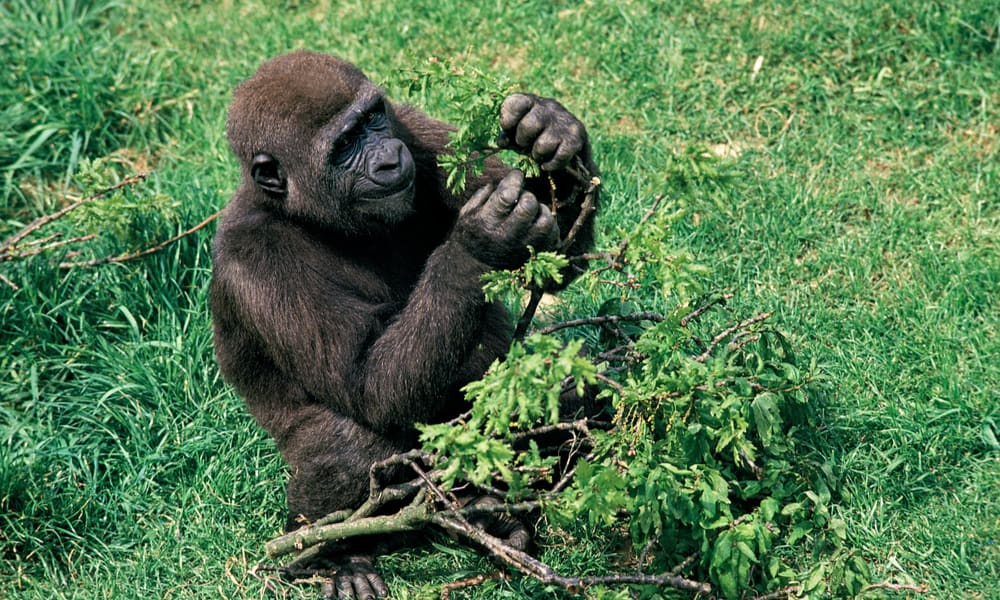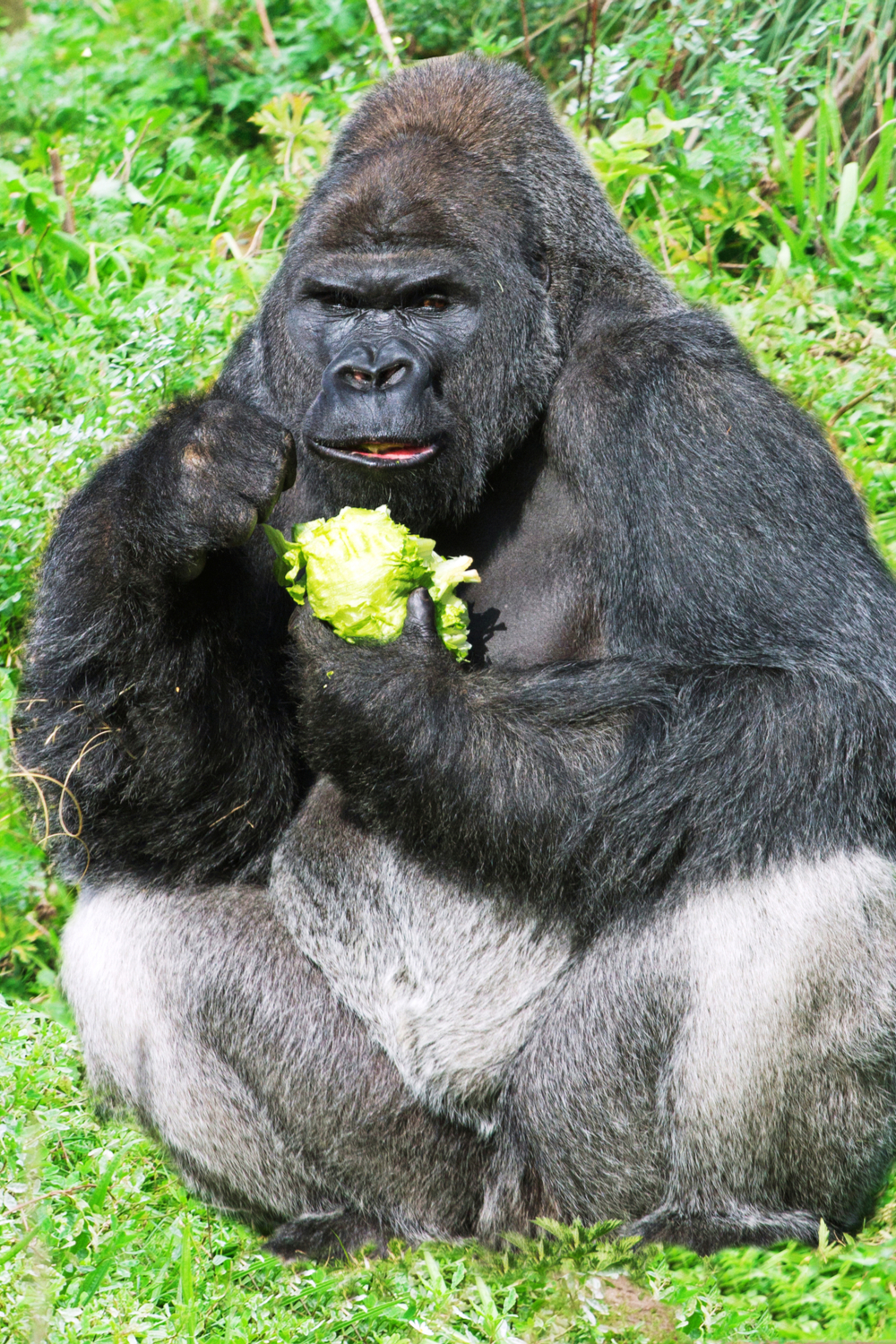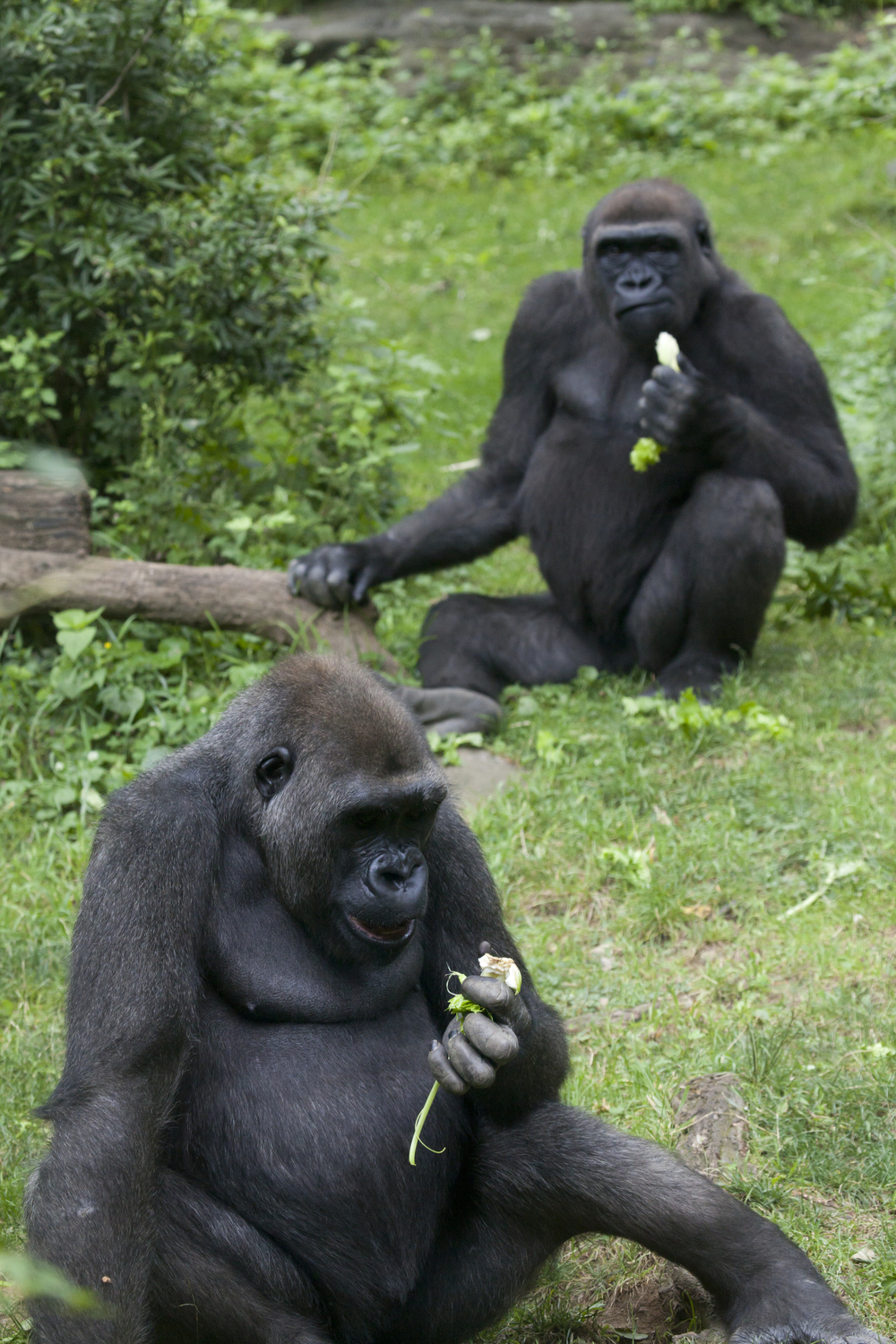Gorillas may come across as fierce and intimidating creatures, but they are just misunderstood. Gorillas are actually gentle giants that exhibit many human-like characteristics. You have seen them in cartoons, video games, and even movies like ‘King Kong.’
Other than bananas, what do gorillas eat? Read on for more information.
Gorillas Habits And Biology
Gorillas are the largest living primates native to Africa, reaching heights ranging from 1.2-1.8 meters and weighing 100-270 kilograms.
They inhabit tropical forests of equatorial Africa. There are two main species of gorillas, each containing two subspecies that occupy different areas.
You can find mountain gorillas in Uganda, Rwanda, and the Democratic Republic of Congo (DRC). Lowland gorillas inhabit the forests of Angola, Equatorial Guinea, the Central African Republic, and the DRC.
Gorillas live in groups referred to as troops and headed by silverbacks. Troops can have as little as two gorillas to fifty gorillas. These groups typically comprise of an adult male and numerous adult females and their young.
The silverback is the heart of the troops’. The “boss” of the group calls all the shots, from mediating conflicts to determining movements of the troops, leading others to feeding sites, and safeguarding them.
Young males of the group, known as blackbacks, are lower-ranking to silverbacks and serve as protection for the troop.
On reaching maturity, the “young” males leave their groups to form or join other troops and become subordinate to the silverback. When the silverback dies, these males may mate with the females or become the dominant males.
Groups of males living together generally have friendly interactions. They stay together, groom each other, and play together. What a blast! Troops full of males will also occasionally participate in homosexual interactions.
Gorillas forage for three to four hours each day. At midday, they rest and resume feeding late in the afternoon.
Each gorilla constructs their own nest except for the infants –baby gorillas. Their nests comprise simple clusters of branches and leaves that they sleep on at night. Sounds comfy right?
Gorillas build new nests each night before they rest because they relocate in the daytime while searching for food. This behavior helps them evade parasites that may nest in their beddings.
What Do Gorillas Eat In The Wild?
Gorillas are herbivores and live on a strict plant diet. They primarily feed on:
- Stems
- Leaves
- Pith (spongy tissue found in the stems of plants).
- Shoots
- Fruits
Despite them being herbivores, they at times feed on insects, larvae, snails, and slugs. These foods are rich in calcium, helping with the formation of their bones.
It is impractical to generalize the diets of all gorillas as the different subspecies feed per the availability and type of food found in their area.
The cross-river gorillas (Gorilla gorilla diehli) feed on fruits, leaves, stems and occasionally supplement their diets with snails and slugs.
The mountain gorillas (Gorilla gorilla beringei) inhabit high-altitude areas. Therefore their habitats lack fruit trees. The better part of their diets includes stems, leaves, and buds of 142 different species of plants. These plants make up about 82% of their diets, with 7% being roots and insects, 3% flowers, and 2% fruits.
The eastern lowland gorillas (Gorilla beringei graueri) feed on 104 different species of plants. When fruits are in plenty, they make up about 26% of their diets.
The western lowland gorillas (Gorilla gorilla gorilla) feed on fruits of more than 100 different trees, 97 of which produce fruit seasonally. 67% of their diets consist of fruits, about 17% are leaves, and the remainder consists of seeds, stems, and insects
Gorillas seldom drink water because they feed on succulent (juicy) vegetation, mainly composed of water and morning dew. Those that do soak the fur on the back of their hands with water and suck it. Quite clever!
Because of the low energy found in plant-based diets, gorillas spend a significant amount of their time engaging in feeding activities to attain the proper nutrition.
Gorillas will rise from their nests as early as possible in search of food and prepare a spot where they can relax while enjoying their meals. The silverbacks usually lead their troops to feeding zones.
An adult gorilla will eat twice a day, in the morning and the evening. Infant gorillas, on the other hand, don’t have strict diets and eat whenever they can.
To obtain their food, gorillas make use of their muscle to tear apart vegetation. Adult males can rip apart whole banana trees to get to the tender pith in the interior—what a show of brute strength.
Like most herbivores, gorillas are typically selective eaters. They only feed on particular parts of a plant. For instance, they’ll only eat the pith, leaves, stalks, and roots of certain plants.
Every gorilla group has a feeding zone, and regardless of their numbers in these groups, all stay within their feeding zones to avoid conflicts with other troops.
Facts About Gorillas
- At least 98% of gorillas’ DNA is similar to that of a human being. Did you know that humans are more closely related to chimpanzees and bonobos?
- Gorilla’s forelimbs (arms) are longer than their hindlimbs (legs), and they use them to aid in walking with their fingers on their hands folded inwards. Walking on all four limbs helps them support their weight.
- Gorillas are highly intelligent. The western lowland gorillas make various tools that aid them in their search for food. An example is using sticks to lure ants and termites from their nests to feed on them.
- The tallest gorilla was shot in Alimbogo, Nothern Kivu, in May 1938. The silverback stood at 1.95 meters tall and weighed 170 kgs.
- Gorillas can get the Ebola virus. In the years 2003 and 2004, two severe outbreaks were recorded.
- Gorillas are prone to a disease known as cardiomyopathy. This disease converts the heart muscles to fibrous bands that stop it from pumping blood, ultimately leading to the primate’s death.
- A female albino gorilla belonging to the western lowland species was once caught. She was named Snowflake and kept at the Barcelona Zoo.
- The most common variety of gorillas found in zoos are the western lowland gorillas.
- Western lowland gorillas are said to be human-like between the ages of 6 and 3.
- At night mountain gorillas sleep together in nests mainly on the ground and in trees. Infants share their nests with their mothers –this ensures that members of the troops keep safe and warm.
- Gorillas spend most of their time eating shoots and leaves. Some are also known to eat snails, bark, ants, and termites.
- Females bear one infant every four to six years and care for them for several years. Their slow rate of reproduction makes it harder for them to recover from population decline.
- Silverbacks are typically 12 years or older and are named distinctively for the silver hair on their backs. They also have large canine teeth that grow as they mature.
- Males and females leave their native troops on reaching maturity to form or join other troops.
- Females tend to be aggressive to each other as they compete for the attention of males.
- Females mature as early as 10-12 years, where they may first fall pregnant. Males mature between 11-13 years, but they can be fertile before reaching adulthood.
- When trying to attract males, females pucker their lips and slowly approach males while maintaining eye contact. They do so to encourage males to initiate the mating process. To capture the attention of unresponsive males, they act out by slapping the ground.
- Female gorillas cut their umbilical cords after giving birth.
- Silverbacks are very supportive of infants in their troops and shield them from hostility within the group.
- Gorillas have 25 distinct vocalizations used for communication; they mainly use these sounds to communicate within dense vegetation.
- The sounds produced by gorillas can be described as barks or grunts and help identify individuals’ whereabouts while traveling. In addition, they make use of these sounds in social interactions where discipline is required.
- The most common form of communication within groups is heard during feeding time, where deep rumbling belches indicate satisfaction.
- Gorillas can laugh, grieve, live emotional lives, develop family bonds, and think about the past and future like other great ape families.
- Gorillas are classified as critically endangered, meaning they face a high risk of extinction. Destruction of their habitat, poaching, and disease are the main threats they face.
- Despite gorillas being herbivores, they don’t damage vegetation when feeding. They are not messy eaters, and their approach to collecting leaves, roots, stems, e.t.c., does not deplete the plant; the plant is still able to grow.
Frequently Asked Questions (FAQs)
What do gorillas fear?
Gorillas are afraid of reptiles like chameleons, and some even fear caterpillars. In addition, gorillas also fear water and only cross streams if there’s a way of doing it without getting wet such as using logs.
Can gorillas climb trees?
Yes. Gorillas are predominantly ground-dwelling apes but will climb trees that can support their weights to reach fruits. Some will also build their nests on trees. Young gorillas are better climbers due to their small size and often climb on trees to play.
Why is it dangerous to make eye contact with a gorilla?
Looking a silverback gorilla directly in the eyes can be dangerous and prompt it to charge at you. Gorillas consider eye contact a challenge as it’s a sign that you’re an enemy and have come to disrupt their family.
Summary
Despite gorillas being endangered, they are well adapted to their environments and belong in the wild. These gentle giants’ similarity to humans is undeniable, and more should be done to protect them. We hope you found this article on “what gorillas eat?” helpful?



It amuses me knowing that gorillas are herbivorous but they grow fatter than chimpanzees who at times feed on meat.
Thanks to the author!!